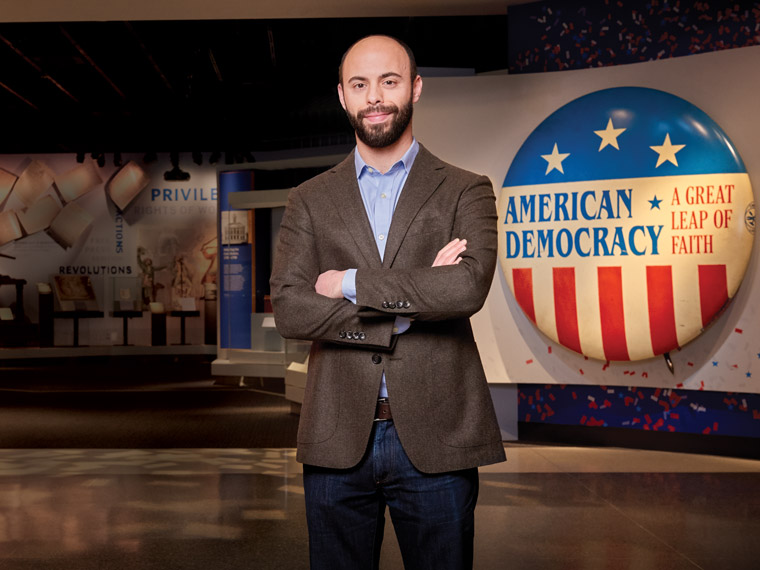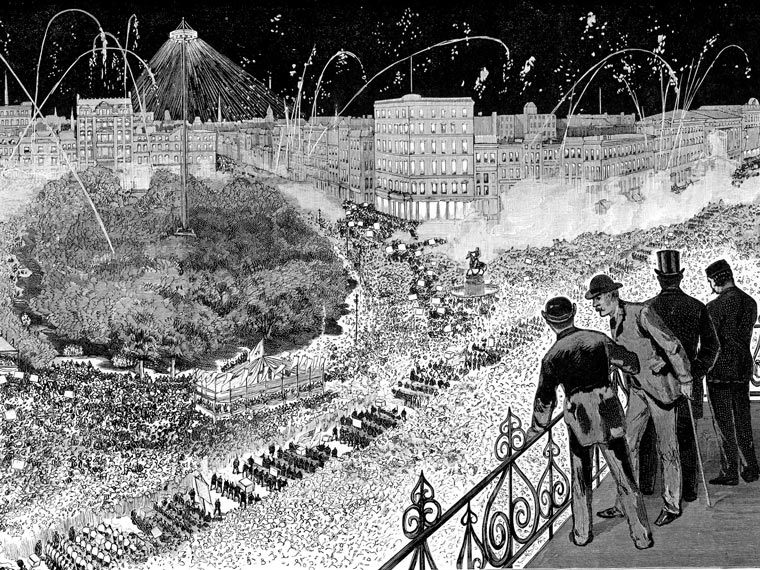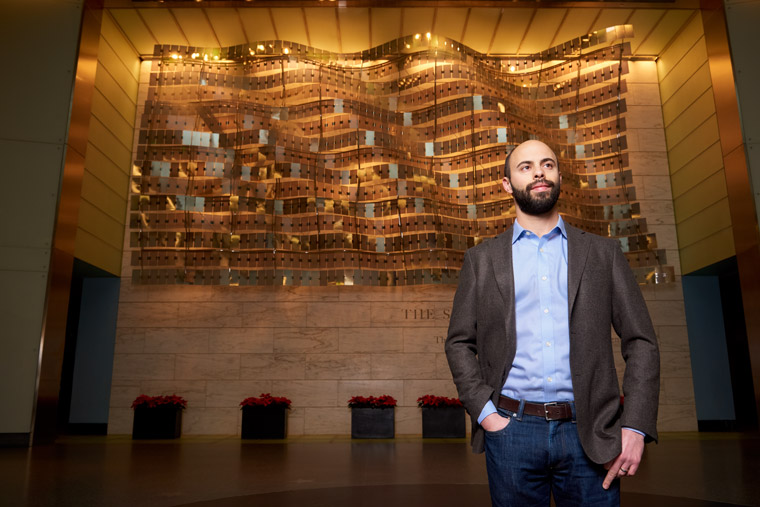At one of America’s foremost museums, Jon Grinspan ’06 documents the nation’s political history—and what it can teach us today.
Jon Grinspan ’06 spends much of his time in the 19th century, trying to understand why Americans voted then in such greater numbers and with such greater fervor than Americans vote now. Torches often illuminate his explorations.
“This one is from the 1890s,” he says in a storage room down the hall from his office, inside the Smithsonian’s National Museum of American History, holding what looks like a crude scepter with a mouthpiece like a bassoon—a torch from a 19th-century campaign rally. Marchers would fill the hollow tube with lycopodium, an explosive powder, then blow into the mouthpiece, propelling the powder up through the wick. “It would shoot a burst of flame 20 feet into the air,” Grinspan says. “Imagine 100 young men blowing like this at the same time and 100 bursts of flame.”
American politics in the 19th century was an enterprise of fire and blood, liquor and cash. Opinions were expressed with knives, and votes were for sale for a drink or a dollar. Men donned oil-resistant capes and paraded through the streets, holding torches aloft. Bonfires blazed, and barroom brawls swelled into riots. And elections routinely drew 80 percent or more of eligible voters.
“Nineteenth-century democracy is public, partisan, and passionate,” says Grinspan, a curator in the Division of Political History at the museum, the home of Lincoln’s top hat and Dorothy’s ruby slippers. “It’s the thing people talk about the most on railroads and in saloons. There are two parties that are incredibly divided, and those parties attract all other identities to them.”
Some of those campaign torches are on display a couple of floors down from Grinspan’s office, in an exhibition titled American Democracy: A Great Leap of Faith. A few steps away is an item from near the end of the 19th century, when voter turnout started a long decline to the anemic levels that have only recently begun to rise again: a voting machine from 1898.
“That curtain,” Grinspan says, pointing to the green cloth that voters drew behind them to shield their choices. “To me, that tells the story that I’m trying to talk about, of a big public political culture going inside, going behind the curtain, and the tradeoffs of that.”
Through elementary and high school in Philadelphia, and then at Sarah Lawrence, Grinspan read about all eras before focusing on 19th-century America for his doctorate at the University of Virginia. “I liked that period of American history because it was just distant enough that I felt like I didn’t have a dog in the fight, but I could still make it relevant to people,” he says.
He was particularly struck by how passionate Americans were about politics in that era, and he started reading the diaries and letters of young people who followed elections as fervently as young people today follow quarterbacks and pop stars. His dissertation led to his first book, The Virgin Vote: How Young Americans Made Democracy Social, Politics Personal, and Voting Popular in the Nineteenth Century (University of North Carolina Press, 2016). Grinspan invoked an engaging cast of vivid characters, such as Oscar Lawrence Jackson, a 19-year-old Ohio schoolteacher who stumped for Abraham Lincoln in 1860, firing up torch-lit crowds with his speeches and carrying a bowie knife in case any of the Democratic hecklers decided to escalate the debate.
“I wanted to write a history book. I didn’t want to write a 500-page dissertation that was incomprehensible,” says Grinspan, an admirer of historians such as Barbara Tuchman and Richard Hofstadter, who reached an audience beyond academia.
Grinspan started engaging the public when barely out of Sarah Lawrence, writing regularly for American Heritage on subjects such as “The Last Gold Rush” and “Trying to Assassinate President Jackson.” In graduate school he contributed to The New York Times Civil War sesquicentennial blog, Disunion, where his story on “How Coffee Fueled the Civil War” had coffee roasters contacting him for tips. “It’s something most Civil War historians took for granted, that soldiers were talking about coffee all the time,” Grinspan says, “but I realized it wasn’t common knowledge.”
He’s continued to write for the Times and The Atlantic since joining the Smithsonian, and he’s working on his second book, tentatively titled Is Democracy a Failure? A Father, a Daughter, and the Birth of Our Abnormal Norms. The father is William “Pig Iron” Kelley (1814–1890), an old-school pol who represented Philadelphia in Congress for three decades; the daughter is Florence Kelley (1859–1932), his reform-minded daughter; and the “abnormal norm” is the way he describes the larger story—how many Americans started to believe that the democratic experiment had gone maybe a step too far, and how the torch-lit rumble of the 19th century gave way to an era of more restrained politics and declining voter turnout in the 20th century.
Almost 82 percent of eligible voters participated in the 1876 presidential election, the highest turnout in American history.
“Their personal story maps really well into these bigger changes that I’m trying to talk about, which actually, I think, speak to what’s going on today in important ways,” Grinspan says of the Kelleys. “What I’m trying to understand more is how politics changed and how democracy’s role in American culture changed in the late 19th and early 20th centuries, and how that relates to what’s going on today.”
Almost 82 percent of eligible voters participated in the 1876 presidential election, the highest turnout in American history. By 1924, voter turnout dwindled to less than 49 percent, the lowest. Through the decades since, turnout has stayed mostly in the 50s.
“The cons were that it was a lot uglier and a lot more subjective, and the lack of restraint was potentially more violent and heated and damaging to public life,” Grinspan says about 19th-century politics. “On the other hand, the 19th century got huge voter turnout and engagement that we lost in the 20th century, and it got working-class people to be engaged in politics in a way they’re not in the 20th century. So at least in the past there was this tradeoff: Do you want this clean, restrained, upper-middle-class political system that’s a little smaller, or do you want a bigger, looser one that maybe incorporates more people?”
But restrained is not an adjective much employed lately when describing American politics. Does that mean the nation is moving back toward that 19th-century model? “My understanding of why public, partisan, angry politics takes over in the 19th century is that in a culture with a lot of social disorder—from the economy, from immigration—in this kind of swirling mess, politics is a really easy thing for people to gravitate to in order to organize their lives,” Grinspan says. “People look to the political system to help their social problems, but the political system can’t usually address those problems, or won’t, and so it just makes everything feel worse.”
“The forces that brought Trump to power demonstrate things that have been going on in our politics for 10 or 15 years. He’s a result; he’s not a cause.”
Among the new items Grinspan has acquired for the museum is a torch from the white nationalist parade in Charlottesville last summer. “I think you can make the case that increasing income inequality and social disorder have made us again gravitate toward these parties to organize everything else,” he says. “This is not about Donald Trump. The forces that brought Trump to power demonstrate things that have been going on in our politics for 10 or 15 years. He’s a result; he’s not a cause.”
Grinspan saw evidence of today’s messy politics at the 2016 Democratic National Convention. He’d gone to Philadelphia to scout for more objects to join the 130,000 in the political history division’s collection, which ranges from first ladies’ inaugural gowns to pink pussy hats from the Women’s March on Washington. At a protest outside Philadelphia’s City Hall, Grinspan spotted a Bernie Sanders supporter from Colorado carrying a rain-smeared umbrella emblazoned with slogans. “On the one hand, it’s the same idea,” he says, back up in the storage room, opening the Sanders umbrella and then comparing it to a dainty, fringed “I Like Ike” umbrella from 1952. “On the other hand, this Eisenhower umbrella is 20th-century politics. Somebody demurely carried this one, but this guy scrawled all over his.”
After corresponding with the Sanders supporter for months after the convention, Grinspan finally persuaded him to donate the umbrella. “It took a little convincing,” he says. “But his kids were excited by the idea of his having something in the Smithsonian.”
Written by Kevin Coyne
Photography by Mike Morgan
The Smithsonian describes American Democracy: A Great Leap of Faith, an ongoing exhibition at the National Museum of American History, as a celebration of “the bold and radical experiment to create a government of the people, by the people, and for the people”—noting that democracy is still a work in progress. Grinspan was a member of the team that created the exhibit, which includes the portable desk Jefferson employed while composing the Declaration of Independence, the inkstand Lincoln used to draft the Emancipation Proclamation, and the table on which Elizabeth Cady Stanton wrote the Declaration of Sentiments.


